I've always loved Rogue Trader, but the impetus for my recent push to paint all of Citadel's RT601 Adventurers was the publication of Joseph McCullogh's Stargrave (Osprey, 2021).
I see Stargrave as the true heir to Rogue Trader. In some ways, the two games couldn't be more different. Rick Priestly's masterpiece from the '80's is dense as a Bible, with hundreds of illustrations, a sprawling backstory, and detailed rules governing everything from orbital lasers to cavalry charges. Stargrave is smaller, devoid of flavor text, and much more targeted: it provides rules for running a crew of 10 interstellar freebooters, and that's it.
 |
| A game of Stargrave |
Beyond the cosmetic differences, the similarities run deep. Both are attempts to re-implement fantasy rules into a sci-fi setting: Rogue Trader from Warhammer Fantasy Battle, and Stargrave from Frostgrave. The common origin in fantasy gives the games an aura of whimsical space opera, even though both introduce dark doses of apocalypticism to create a complex mix (Stargrave's tagline is "Science Fiction Wargames in the Ravaged Galaxy" while 40K's is "There is only WAR"). Most importantly, Stargrave and Rogue Trader incorporate elements of roleplaying. In Rogue Trader, it comes through the game master, who runs a scenario with hidden information, elaborate subplots, and campaign continuity. In Stargrave, the captain of your crew becomes your player character and develops better abilities from session to session. In both games, the feeling of roleplaying puts a special emphasis on character -- especially characterful miniatures. In that sense, it's no surprise that the same sculptor, Mark Copplestone, provided miniatures both for Stargrave and for the RT601 Adventurers.
Well, let's see the last seven miniatures in the RT601 range!
* * * * *
First is RT601 "Pilot Rav". If I had to guess, I'd say this was a Copplestone design, because of the clean lines, open face, and aroma of pulp adventure.
Second is the RT601 "Space Pirate", later renamed "Lan Duval".
The curious thing about the above miniature is his startling resemblance to a design from the same period by Trish Morrison, the Talisman Timescape "Space Pirate" (pictured below on the left). Citadel is well-known for basing two or more sibling miniatures on one prototype (i.e. Kylla Condotti and No Face Fargo) where the basic pose is the same but identifying traits are switched out (usually the face and the weapon). However, in this situation, the Space Pirates share a similar face, a similar weapon, and similar outfits, although all the minor details are different. Maybe Aly Morrison and Trish Morrison decided to each sculpt the same fellow in an excess of marital bliss.
Next we have the RT601 "Cyborg".
The above miniature also bears a striking resemblance to the Talisman Timescape "Cyborg" by Trish Morrison (below on the left). Once again, the identifying traits are all quite similar, but the details and the poses differ. It just goes to show that when Rogue Trader first came out, it was not so different from a zany game like Talisman Timescape to prevent the miniatures from being mutually compatible.
Below is the RT601 "Bandit". Methinks he bears some relationship to the Talisman Timescape "Archaeologist".
This is the RT601 "Ship's Officer". On his slotta-tab is carved the alternative name "Astronaut". It will no longer surprise you to learn that he shares many traits with the Talisman Timescape "Astronaut" by Trish Morrison.
Behold the RT601 "Imperial Assassin". She was the last of this range to come into my collection. I thought she'd never arrive. All Praise to the Emperor - the Emperor Provides!And finally, the last miniature in the RT601 range is the "Mad Punk". I saved her for last because I think she's my favourite paintjob of the lot: a nice, clean lick of paint.
Many thanks for staying with me over this long series of posts!




















